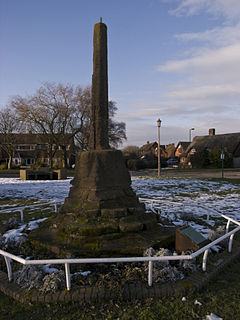Meriden, West Midlands
| Meriden | |
|---|---|
 The traditional centre of England |
|
| Meriden shown within the West Midlands | |
| Population | 11,686 (2011.Ward) |
| OS grid reference | SP240824 |
| Civil parish |
|
| Metropolitan borough | |
| Metropolitan county | |
| Region | |
| Country | England |
| Sovereign state | United Kingdom |
| Post town | COVENTRY |
| Postcode district | CV7 |
| Dialling code | 01676 |
| Police | West Midlands |
| Fire | West Midlands |
| Ambulance | West Midlands |
| EU Parliament | West Midlands |
| UK Parliament | |
Meriden is a village and civil parish in the Metropolitan Borough of Solihull, West Midlands, England. It is located between Solihull and the city of Coventry, and is approximately 10 km (6.2 mi) from Birmingham Airport.
The American city of Meriden, Connecticut is named after the village.
Historically part of Warwickshire, the surrounding countryside, known as the Meriden Gap, forms a green belt between the two urban areas of Birmingham and Coventry. It gives its name to the Meriden parliamentary constituency, which covers the Meriden Gap.
The A45 bypass opened in 1958.
In the United Kingdom Census 2001 the population of the Meriden parish was 2,734.
It is possibly the site of an Iron Age field system.
The original name of the village was Alspath and it was centred on the site of the parish church. Over the period 15C to 17C the name 'Meriden' gradually supplants that of Alspath. The parish church of St. Laurence was built on the site of a simple Saxon church erected on her own land by Lady Godiva - the wife of Leofric Earl of Mercia in the years prior to the Norman conquest; however although references to a church/chapel dedicated to St Edmund on the site have been found no physical remains have ever been uncovered. The present church was built in several stages. The nave and two thirds of the chancel were finished by the late 12C - late Norman - and were built as an expiation for sins committed during the civil war between Stephen & Matilda. The chancel was extended in 13C; the south aisle was added in the late 14C. The north aisle was added in the early 15C as was the tower; and the Norman roof was replaced in 15C also. By 1831 the aisles had been rebuilt with galleries and you can see the industrial quality of the stonework outside the building compared to the 14/15C stonework inside. In 1883 the church was restored again and the galleries were removed. At some point the 15C wooden ceilings of both nave and chancel had been plastered over - uncovered during a restoration in 1924; and finally extensive restorations of the medieval roof and tower were carried out circa 2006-10. The St. Laurence/Lawrence (the spelling is interchangeable) to whom the church is dedicated may either be Lawrence of Rome who was one of the seven deacons of the early church martyred during the persecution of Emperor Valerian in 258 A.D.; or it may have been Laurence of Canterbury who became the second archbishop in 604 A.D. Legend favours the latter though, from 1318 onwards, the choice of 10 Aug for the Patronal feast day and the village fair (up until 1959) would indicate the Roman Lawrence; so the issue remains unclear.
...
Wikipedia

